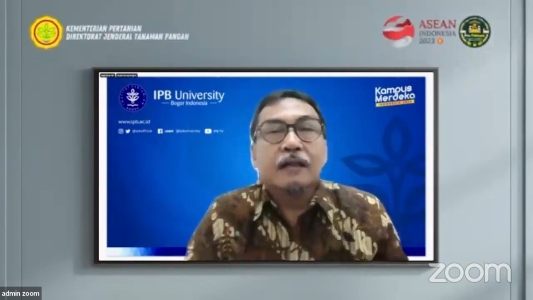Protecting Agroecosystems, Dr Ali Nurmansyah Explains the OPT Forecasting Model and The Criteria for Its Success

Plant pest forecasting (OPT) is an important part of implementing control mechanisms (PHT). This effort is important to protect agroecosystems that are resistant to pest disturbances, especially because pests and diseases are one of the four main factors that affect crop production.
Dr Ali Nurmansyah, IPB University lecturer from the Department of Plant Protection (PTN), Faculty of Agriculture explained, the pest forecasting model is a depiction of the interaction system between pests with plants and environmental factors in the future.
"In making a forecasting model, it requires data on pest and disease attacks from several previous seasons, at least 10 years earlier to test the accuracy of the forecasting model," he said in a Propaktani Webinar entitled 'Climate and OPT Forecasting' online with the Directorate General of Food Crops, Ministry of RI, some time ago.
Dr Ali said, this forecasting model must meet several criteria for the forecasting system to be declared successful. The criteria for a successful forecasting system must be reliable, simple, important, useful, multipurpose and cost-effective.
"Reliable means using biological and environmental data as input. Simple means easy to implement and use by farmers. Important means it is used for pests and diseases that are economically detrimental," he explained.
Meanwhile, he added, useful means that the forecasting model can be used when pests become a problem. Multipurpose application means monitoring and control decision-making tools. Cost-effective means it does not require expensive costs in its application.
"Accurate OPT forecasting results will provide information about the population, intensity of attack, area of attack and spread of pests and diseases in the future space and time," he added.
The forecasting, said Dr Ali, will be used as a basis for developing strategies and techniques for effective and efficient pest and disease management or control. Thus, it can minimize the risk of farming, the population of pests can be suppressed, the level of plant productivity at a high level and safe for the environment.
He added that pest forecasting can use simple mathematical models or with the help of artificial intelligence. Mathematical forecasting models usually use functions. The type of function used is adjusted to the attack data or the interaction of pests and other factors. The relationship pattern is not only linear.
"The preparation of this forecasting model begins with statistical analysis. Then it is continued with regression analysis to determine the best model," he said.
Meanwhile, models using the latest technology, namely artificial intelligence in pest forecasting, require a more complicated and lengthy process. The data used is more complex and combined with meteorological data. However, the forecasting model is considered better and more accurate.
"Machine learning models are certainly more complicated, but they tend to provide more accurate results than mathematical models," he concluded. (MW/Rz) (IAAS/RUM)



